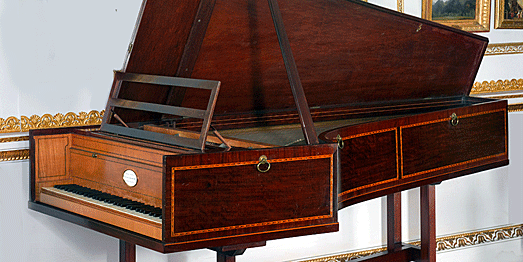|
The Queen of Pianos
by Bob Brooke
 In
the 18th century, many instruments, known as clavicitherium,
featured the strings of a harpsichord on a vertical frame. The
clavicitherium was the inspiration for the first upright piano
created by John Isaac Hawkins, an Englishman living in Philadelphia,
in 1800. In
the 18th century, many instruments, known as clavicitherium,
featured the strings of a harpsichord on a vertical frame. The
clavicitherium was the inspiration for the first upright piano
created by John Isaac Hawkins, an Englishman living in Philadelphia,
in 1800.
The idea of placing the strings vertically had existed for many
years. Domenico Del Mela, an Italian engineer, is often considered
the inventor of the upright piano for his vertically placed piano.
However, his pianos were extremely tall, as the strings started at
the height of the keys. Indeed, musicians called these pianos
Giraffenflügel due to their great height. Hawkins’ genius was in
simply starting the strings from the floor. In addition, he added a
complete iron frame for the instrument and suspended soundboard.
Together, these features created a more compact and acceptable
sounding instrument.
 Craftsmen
made the first pianos individually by hand. Although piano music had
mostly been confined to the aristocracy, it became popular with the
general public following the French Revolution in 1789, and demand
for instruments increased. This led to the rapid growth of piano
manufacturing. Craftsmen
made the first pianos individually by hand. Although piano music had
mostly been confined to the aristocracy, it became popular with the
general public following the French Revolution in 1789, and demand
for instruments increased. This led to the rapid growth of piano
manufacturing.
As the 19th century progressed, the technology behind the upright
piano advanced further. Another English inventor, Robert Wornum,
added the “tape check” action. The action greatly improved the sound
quality of the pianos, a result of new mechanisms, including a
spring which helped the hammer return to its resting position
instead of relying on the weight of the keys. By 1812, the upright
piano had grown in popularity extensively. An issue of the
Repository of Arts in 1812, listed the item as in great demand
because the “instrument had a very high degree of reputation”.
As the demand for pianos increased, manufacturers increasingly
turned to mass production. When pianists began competing with
embellishments such as trills or fast arpeggios, or by repeating
fast passages, they began to desire more sensitive piano actions. In
1821, Pierre Erard, in response to this need, created a
revolutionary new action that made it possible to repeat notes
quickly.
Up to the end of the 18th century, the standard range, or compass,
of the piano keyboard was 61 keys, spanning five octaves). However,
between 1810 and 1886 the compass gradually extended to 82 keys.

 In
1826, Robert Wormum invented the mechanical action structure of the
upright piano in London, England, and overnight made the piano useable
in just about any home. Because upright pianos took less space than a
grand piano, they were a better size for use in private homes for
domestic music-making and practice. In
1826, Robert Wormum invented the mechanical action structure of the
upright piano in London, England, and overnight made the piano useable
in just about any home. Because upright pianos took less space than a
grand piano, they were a better size for use in private homes for
domestic music-making and practice.
Upright pianos, also called vertical pianos, are more compact due to the
vertical structure of the frame and strings. The hammers move
horizontally, and return to their resting position via springs, which
are susceptible to degradation. Manufacturers sometimes marketed upright
pianos with unusually tall frames and long strings as an upright grand
pianos. Modern pianos are often classified according to their height and
to modifications of the action that are necessary to accommodate that
height. Upright pianos are generally less expensive than grand pianos.
Today, they can be found in schools, churches, community centers, music
conservatories, and university music programs as rehearsal and practice
instruments, as well as in homes.

The top of a spinet model barely rises above the keyboard. Unlike all
other pianos, the spinet action is located below the keys, operated by
vertical wires that are attached to the backs of the keys.
Studio pianos stand between 42 and 45 inches tall. This is the shortest
cabinet that can accommodate a full-sized action located above the
keyboard. Manufacturers refer to anything taller than a studio piano as
an upright.
<
Back to More Antique Spotlights
Next Article >
|
